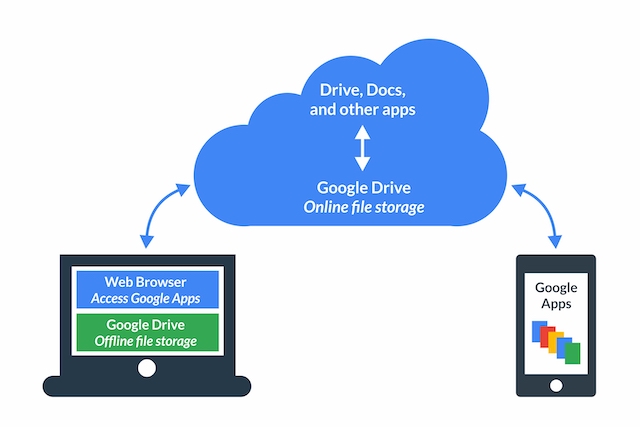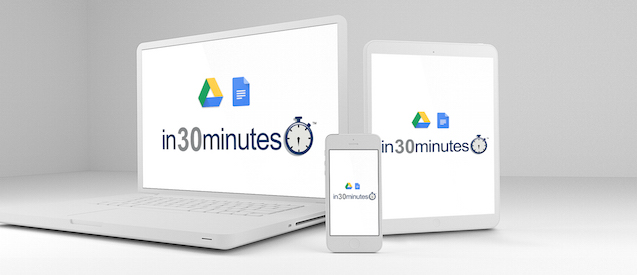I recently purchased a Chromebook in a move to replace my Dell Laptop using Microsoft Office. I’m in the process of going through your guide and hopefully it will help me understand the use of the Google software and some structure of the Chrome OS. My biggest hangup right now is understanding when I’m working on this computer and when I’m actually working in the cloud. I wish they labeled the Drive and My Files differently to give me that feeling where I’m at and using their software. I’m used to manipulating files, dragging and dropping, making new folders, bringing in new files via USB and email attachments, and I see that does not work in every instance here (drag/drop). It is not the feel that I’ve had for years (C: A: D: E: drives) knowing where I’m working.
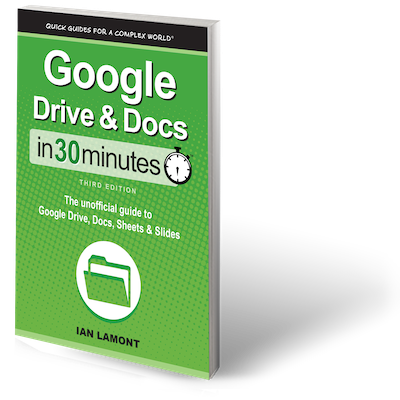
 Publisher i30 Media today released a completely updated edition of Google Drive & Docs In 30 Minutes: The unofficial guide to Google Drive, Docs, Sheets & Slides (ISBN: 978-1-64188-054-1) by author Ian Lamont.
Publisher i30 Media today released a completely updated edition of Google Drive & Docs In 30 Minutes: The unofficial guide to Google Drive, Docs, Sheets & Slides (ISBN: 978-1-64188-054-1) by author Ian Lamont.
“This guide has been our top-selling title in the IN 30 MINUTES series since the first edition was published in 2013,” said Lamont, who is also the president and founder of i30 Media. “As Google has made many major improvements to the software in recent years, I thought it was really important to update the entire text.”
In addition to covering the more popular browser-based applications such as Google Drive (online file storage), Google Docs (a word processor), and Google Sheets (a spreadsheet program), the third edition of the book covers newer applications and features including Google Forms (an online survey tool), Google Sites (a simple website builder), and live collaboration.
The tone is friendly and easy to understand, with lots of step-by-step instructions and examples and nearly 50 screenshots. The guide can be used by anyone with a PC, Mac, or Chromebook. Mobile apps are not included in this edition.
More information about Google Drive & Docs In 30 Minutes, Third Edition as well as online ordering options can be found on the companion website, googledrive.in30minutes.com. The site also includes blog posts, videos, and other resources for readers. The paperback retail price is $13.99, while the ebook and PDF edition is available for $9.99. A hardcover edition is available for $22.99.
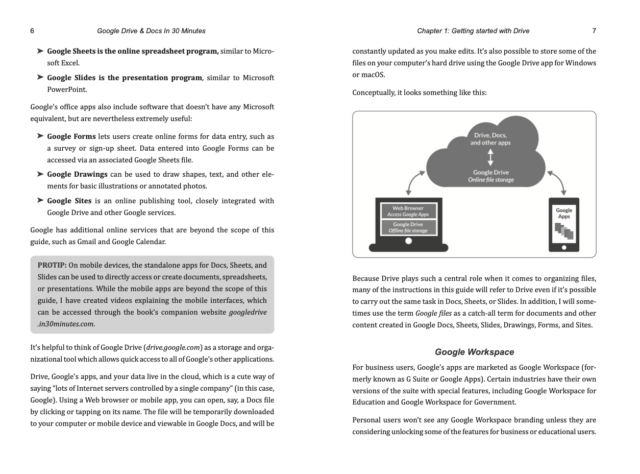
A sample page from Chapter 1 of Google Drive & Docs In 30 Minutes
About the author
Google Drive & Docs In 30 Minutes is authored by Ian Lamont, an award-winning business and technology journalist and the founder of i30 Media Corporation. His media career has spanned more than 25 years across three continents, including a stint in the British music industry and a six-year residence in Taipei, where he learned Mandarin and worked for a local TV network and newspaper.
Lamont’s editorial work has garnered industry awards from the Society of American Business Editors and Writers (SABEW) and the American Society of Business Publication Editors (ASBPE). His books include Dropbox In 30 Minutes, Twitter In 30 Minutes, and Lean Media: How to focus creativity, streamline production, and create media that audiences love.
Lamont is a graduate of the Boston University College of Communication and MIT’s Sloan Fellows program. He lives with his family in the Boston area.
About In 30 Minutes guides
i30 Media is the publisher of IN 30 MINUTES guides – “Quick guides for a complex world.” Thousands of readers turn to IN 30 MINUTES guides to understand mildly complex topics, ranging from home-buying to social media. The tone is friendly and easy to understand, with step-by-step instructions and lots of examples. The series has won multiple awards from the Independent Book Publishers Association and Foreword Reviews. Top-selling titles include Google Drive & Docs In 30 Minutes, Twitter In 30 Minutes, and LinkedIn In 30 Minutes. For more information about the series, visit in30minutes.com.
Newton, Mass. — Today, publisher i30 Media Corporation is pleased to announce Google Drive & Docs In 30 Minutes (2nd Edition) has been recognized as a finalist in the 21st annual Foreword INDIES Book of the Year Awards.
As part of its mission to discover, review, and share the best books from university and independent publishers, Foreword Magazine, Inc. hosts an annual awards program each year. Finalists represent the best books published in 2018. After more than 2,000 individual titles spread across 56 genres were submitted for consideration, the list of finalists was determined by Foreword’s editorial team. Winners will be decided by an expert team of booksellers and librarians—representing Foreword’s readership—from across the country.
“Google Drive & Docs In 30 Minutes is our most popular title, and it’s wonderful to get this type of professional recognition,” said author Ian Lamont, who founded i30 Media and the IN 30 MINUTES series of guidebooks in 2013. “The reference category has many strong contenders, and it’s an honor to be listed among them.”
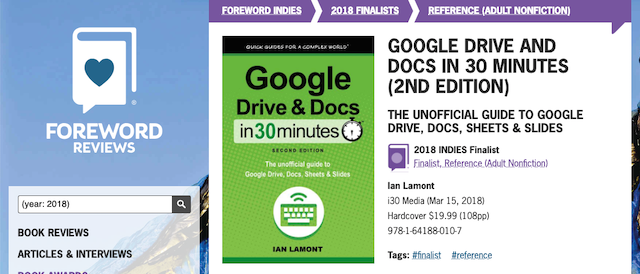 Winners in each genre—along with Editor’s Choice Prize winners and Foreword’s INDIE Publisher of the Year—will be announced June 14, 2019.
Winners in each genre—along with Editor’s Choice Prize winners and Foreword’s INDIE Publisher of the Year—will be announced June 14, 2019.
Founded in 1998, Foreword Magazine, Inc. is the only media company completely devoted to independent publishing. Publishers of a Folio: award-winning bimonthly print review journal, special interest products, and daily online content feeds, Foreword exclusively covers university and independent (non “Big 5”) publishers, the books they publish, and their authors. Foreword is based in Traverse City, Michigan, with staff based worldwide.
Publisher i30 Media is pleased to announce a new product line: In 30 Minutes video classes. We’re starting with the Google Drive & Docs In 30 Minutes video course (For a limited time, available at a 25% discount on Gumroad or available as a video class on Udemy), but will expand to other topics soon. You can learn more about the Google Drive and Docs video here, and we will also distribute the class to other online educational platforms.
The idea for In 30 Minutes video classes has been around almost as long as the book series. Around the same time the ebook and paperback versions of Google Drive & Docs In 30 Minutes were launched, i30 Media posted a series of short video screencasts on YouTube. They were very popular — one video that shows how to convert a PDF to Microsoft Word or Google Docs has garnered tens of thousands of views. Would people be interested in watching a longer video course about Google’s free online office suite? The popularity of the YouTube videos indicated that the answer was probably “yes” … but it would require a lot of work, ranging from writing a script to setting up a studio to shoot the on-screen narrations and screencast demonstrations.
What’s inside the Google Drive & Google Docs video class?
Here’s an excerpt from the description of Google Drive & Docs In 30 Minutes (video class):
This 30-minute class is narrated by the author of the top-selling guide, Google Drive & Google Docs In 30 Minutes. The course includes lectures on registration, finding and organizing files, creating documents and formatting them, working with Microsoft Word documents in Google Docs, and a complete review of the interfaces for Google Drive and Google Docs on the Web and mobile devices. The tone of this guide is friendly and easy to understand, with lots of step-by-step instructions and examples that show exactly what to do.
In addition to serving as a solid introduction to new users, it’s great for people making the transition from Microsoft Office, not to mention teachers using Google Drive for education and Google Docs in the classroom.
Here is the lecture list:
- Introduction
- The Google Drive user interface
- The Google Docs user interface
- Using the Google Drive and Google Docs mobile apps
- Formatting in Google Docs
- Formatting Microsoft Word files in Google Docs
- The Google Drive desktop application for syncing and storage
- Collaboration
We hope the Google Drive video classes prove as popular as the ebook/paperback versions of the guide. In addition, we will be paying close attention to how people use the course in order to improve the video tutorials and create new instructional videos based on popular topics.
I’ve lamented the state of competition in the ebook platform wars in the past.
Take Apple, which had so much going for it 3 or 4 years ago compared to Amazon, with a vastly superior e-reader (the iPad using iBooks) and sales that regularly topped $200 per month for my In 30 Minutes series of how-to guides. Apple’s hardware/software advantage did not last. Amazon eventually closed the hardware gap with the Kindle Fire, and continued to make improvements to the Kindle software and ordering processes. Meanwhile, Apple’s bloated iTunes/iBookstore has continued to frustrate users attempting to buy or review books, contributing to a stagnant sales picture. So where did Apple place its platform improvement efforts while Amazon was catching up, you ask? Creating a superb closed-garden authoring tool (see my iBooks Author review here) which has done little for sales in the iBookstore and makes it impossible to export the efforts to any other channel.
Then there is Google Play Books and the partner center for authors and publishers. Google is the only other deep-pocketed company out there that could ever hope to compete with Amazon in the ebook space, but it too has dropped the ball with its marketplace. I have been selling ebooks there for 3 years, and sales have never been good. But there are a host of other problems that stymie content producers and make it difficult to consider it a serious contender to Amazon KDP.
Google Play Books review: What’s wrong with Google Play Books
Where to begin? How about the unilateral discounts that Google Play applies to pricing. It’s gotten so bad that when I create a new ebook listing in Google Play, I have to refer to this Kboards forum post that lists the amounts you need to input to Google Play books in order to display the desired price:
Set Price = Discounted Price
99c = no change (royalty = 52%)
1.49 = no change (royalty = 52%)
2.49 = 1.92 (Discount = 23%. Actual royalty = 67%)
2.99 = 2.09 (Discount = 30%. Actual royalty = 74%)
3.49 = 2.65 (Discount = 24%. Actual royalty = 68%)
3.94 = 2.99 (Discount = 24%. Actual royalty = 68%)
3.99 = 3.03 (Discount = 24%. Actual royalty = 68%)
4.50 = 3.44 (Discount = 23.5%. Actual royalty = 68%)
4.99 = 3.82 (Discount = 23%. Actual royalty = 68%)
5.18 = 3.99 (Discount = 23%. Actual royalty = 68%)
5.25 = 4.04 (Discount = 23%. Actual royalty = 68%)
5.99 = 4.61 (Discount = 23%. Actual royalty = 67.5%)
6.48 = 4.99 (Discount = 23%. Actual royalty = 68%)
9.99 = 7.99 (Discount = 20%. Actual royalty = 65%)
8.99 = 7.52 (Discount = 16%. Actual royalty = 62%)
15.99 = 9.99 (Discount = 37%. Actual royalty = 83%)
Then there’s the lack of a sales dashboard on Google Play Books. Even Nook and Kobo understand that authors and publishers want quick insights into how their books are selling, and provide an on-screen look at monthly sales:
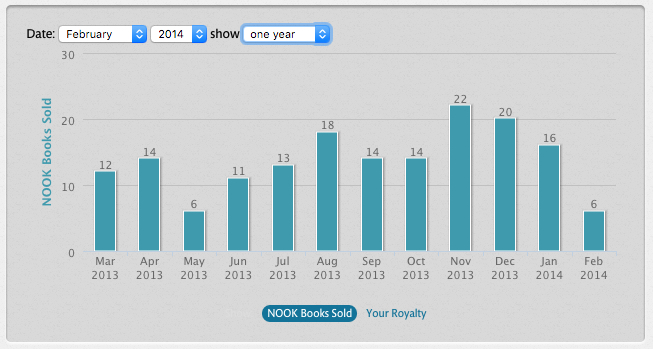
Google Play Books Partner Center, on the other hand, doesn’t have any sales dashboard. It’s only possible to download a .CSV file that contains raw sales data. If you’re handy with Excel or Google Sheets, you can probably set up something that handles basic currency conversion and get a USD total for monthly sales, but if not, you’re out of luck.
Google Play Book reviews include scraped and fake reviews
And then there are the reviews that appear next to my books in the Play Store, written by people who have never downloaded or read them. To be fair, this is a problem with Amazon too, but at least Amazon displays “Verified Purchase” next to the reviews so shoppers know which ones are more trustworthy. Potential customers who venture to Google Play to check out my ebooks are likely to encounter drive-by complaints about the topics covered (“you can get this information on YouTube for free!”) or issues that have nothing to do with my books (such as the person who had a problem recovering a password from some online service). Because Google can’t screen or properly identify real reviews, I’ve taken the step of removing links from my websites to the Google Play Books product pages for half of the titles published. The Google Play product pages have become a liability, and I don’t want to send customers there.
Buy hey, I suppose I should be happy that I at least have access as a publisher, and basic support questions get answered. Nine months ago, Google Play Books closed its doors to new self-published authors and small publishers:
Over the course of the last four weeks there has been a media firestorm about the sheer scope of pirated content on Google Play. This has forced the company to close their Play Books Publisher Portal. In a message in the Google Product Forums, a Google rep said “We’ve temporarily closed new publisher sign ups in the Play Books Partner Center, so we can improve our content management capabilities and our user experience. We’re working to reopen this to new publishers soon. Thanks for your patience.”
As far as I know, Google Play Books is still closed to new authors.
Do you use Google Play Books as an author, publisher, or reader? What has your experience been like? What needs to change?

